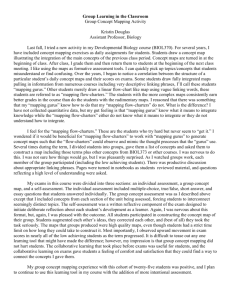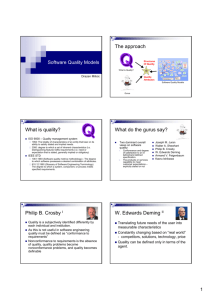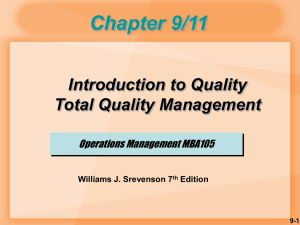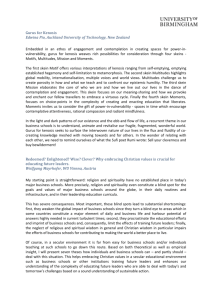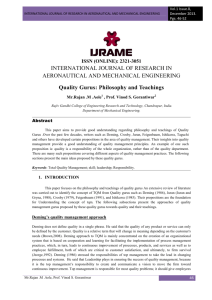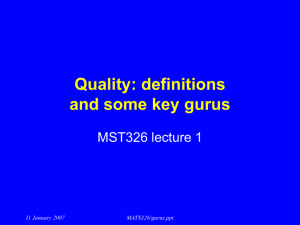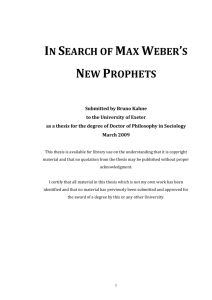The Original Quality Gurus
advertisement
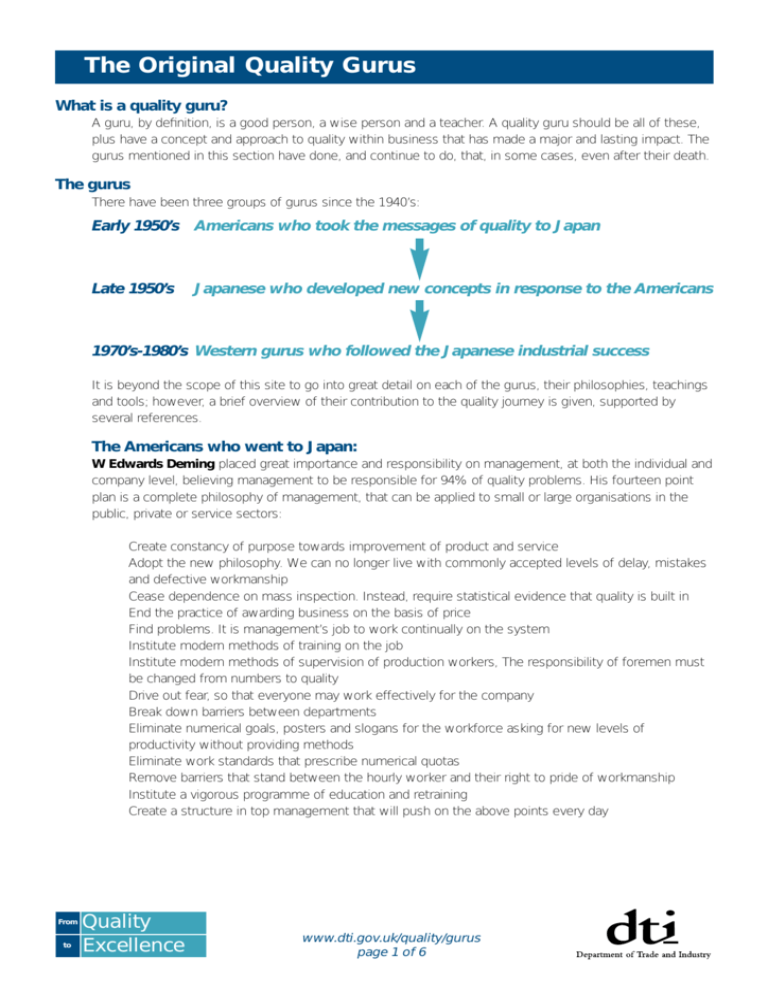
The Original Quality Gurus What is a quality guru? A guru, by definition, is a good person, a wise person and a teacher. A quality guru should be all of these, plus have a concept and approach to quality within business that has made a major and lasting impact. The gurus mentioned in this section have done, and continue to do, that, in some cases, even after their death. The gurus There have been three groups of gurus since the 1940’s: Early 1950’s Americans who took the messages of quality to Japan Late 1950’s Japanese who developed new concepts in response to the Americans 1970’s-1980’s Western gurus who followed the Japanese industrial success It is beyond the scope of this site to go into great detail on each of the gurus, their philosophies, teachings and tools; however, a brief overview of their contribution to the quality journey is given, supported by several references. The Americans who went to Japan: W Edwards Deming placed great importance and responsibility on management, at both the individual and company level, believing management to be responsible for 94% of quality problems. His fourteen point plan is a complete philosophy of management, that can be applied to small or large organisations in the public, private or service sectors: • Create constancy of purpose towards improvement of product and service • Adopt the new philosophy. We can no longer live with commonly accepted levels of delay, mistakes and defective workmanship • Cease dependence on mass inspection. Instead, require statistical evidence that quality is built in • End the practice of awarding business on the basis of price • Find problems. It is management’s job to work continually on the system • Institute modern methods of training on the job • Institute modern methods of supervision of production workers, The responsibility of foremen must be changed from numbers to quality • Drive out fear, so that everyone may work effectively for the company • Break down barriers between departments • Eliminate numerical goals, posters and slogans for the workforce asking for new levels of productivity without providing methods • Eliminate work standards that prescribe numerical quotas • Remove barriers that stand between the hourly worker and their right to pride of workmanship • Institute a vigorous programme of education and retraining • Create a structure in top management that will push on the above points every day From to Quality Excellence www.dti.gov.uk/quality/gurus page 1 of 6 He believed that adoption of, and action on, the fourteen points was a signal that management intended to stay in business. Deming also encouraged a systematic approach to problem solving and promoted the widely known Plan, Do, Check, Act (PDCA) cycle. The PDCA cycle is also known as the Deming cycle, although it was developed by a colleague of Deming, Dr Shewhart. Plan what is needed ACT PLAN Do it Check that it works CHECK DO Act to correct any problems or improve performance It is a universal improvement methodology, the idea being to constantly improve, and thereby reduce the difference between the requirements of the customers and the performance of the process. The cycle is about learning and ongoing improvement, learning what works and what does not in a systematic way; and the cycle repeats; after one cycle is complete, another is started. Dr Joseph M Juran developed the quality trilogy – quality planning, quality control and quality improvement. Good quality management requires quality actions to be planned out, improved and controlled. The process achieves control at one level of quality performance, then plans are made to improve the performance on a project by project basis, using tools and techniques such as Pareto analysis. This activity eventually achieves breakthrough to an improved level, which is again controlled, to prevent any deterioration. Quality Control Holding the gains Pareto Analysis Breakthrough Quality Improvement project-by-project From to Quality Excellence Quality Planning www.dti.gov.uk/quality/gurus page 2 of 6 Juran believed quality is associated with customer satisfaction and dissatisfaction with the product, and emphasised the necessity for ongoing quality improvement through a succession of small improvement projects carried out throughout the organisation. His ten steps to quality improvement are: • • • • • • • • • • Build awareness of the need and opportunity for improvement Set goals for improvement Organise to reach the goals Provide training Carry out projects to solve problems Report progress Give recognition Communicate results Keep score of improvements achieved Maintain momentum He concentrated not just on the end customer, but on other external and internal customers. Each person along the chain, from product designer to final user, is a supplier and a customer. In addition, the person will be a process, carrying out some transformation or activity. SUPPLIER PROCESS CUSTOMER Armand V Feigenbaum was the originator of “total quality control”, often referred to as total quality. He defined it as: “An effective system for integrating quality development, quality maintenance and quality improvement efforts of the various groups within an organisation, so as to enable production and service at the most economical levels that allow full customer satisfaction”. He saw it as a business method and proposed three steps to quality: • Quality leadership • Modern quality technology • Organisational commitment The Japanese: Dr Kaoru Ishikawa made many contributions to quality, the most noteworthy being his total quality viewpoint, company wide quality control, his emphasis on the human side of quality, the Ishikawa diagram and the assembly and use of the “seven basic tools of quality”: • • • • • • • Pareto analysis Cause and effect diagrams Stratification Check sheets Histograms Scatter charts Process control charts which are the big problems? what causes the problems? how is the data made up? how often it occurs or is done? what do overall variations look like? what are the relationships between factors? which variations to control and how? He believed these seven tools should be known widely, if not by everyone, in an organisation and used to analyse problems and develop improvements. Used together they form a powerful kit. From to Quality Excellence www.dti.gov.uk/quality/gurus page 3 of 6 One of the most widely known of these is the Ishikawa (or fishbone or cause and effect) diagram. CAUSES CAUSES PROBLEM or EFFECT Like other tools, it assists groups in quality improvements. The diagram systematically represents and analyses the real causes behind a problem or effect. It organises the major and minor contributing causes leading to one effect (or problem), defines the problem, identifies possible and probable causes by narrowing down the possible ones. It also helps groups to be systematic in the generation of ideas and to check that it has stated the direction of causation correctly. The diagrammatic format helps when presenting results to others. Dr Genichi Taguchi believed it is preferable to design product that is robust or insensitive to variation in the manufacturing process, rather than attempt to control all the many variations during actual manufacture.To put this idea into practice, he took the already established knowledge on experimental design and made it more usable and practical for quality professionals. His message was concerned with the routine optimisation of product and process prior to manufacture rather than quality through inspection. Quality and reliability are pushed back to the design stage where they really belong, and he broke down off-line quality into three stages: Robust product design Level of quality Parameter design Statistical process control Product inspection Quality control procedure and stage of evolution • System design • Parameter design • Tolerance design “Taguchi methodology” is fundamentally a prototyping method that enables the designer to identify the optimal settings to produce a robust product that can survive manufacturing time after time, piece after piece, and provide what the customer wants. Today, companies see a close link between Taguchi methods, which can be viewed along a continuum, and quality function deployment (QFD). Shigeo Shingo is strongly associated with Just-in-Time manufacturing, and was the inventor of the single minute exchange of die (SMED) system, in which set up times are reduced from hours to minutes, and the Poka-Yoke (mistake proofing) system. In Poka Yoke, defects are examined, the production system stopped and immediate feedback given so that the root causes of the problem may be identified and prevented from occurring again. The addition of a checklist recognises that humans can forget or make mistakes! From to Quality Excellence www.dti.gov.uk/quality/gurus page 4 of 6 He distinguished between “errors”, which are inevitable, and “defects”, which result when an error reaches a customer, and the aim of Poka-Yoke is to stop errors becoming defects. Defects arise because errors are made and there is a cause and effect relationship between the two. Zero quality control is the ideal production system and this requires both Poka-Yoke and source inspections. In the latter, errors are looked at before they become defects, and the system is either stopped for correction or the error condition automatically adjusted to prevent it from becoming a defect. Western Gurus: Philip B Crosby is known for the concepts of “Quality is Free” and “Zero Defects”, and his quality improvement process is based on his four absolutes of quality: • • • • Quality is conformance to requirements The system of quality is prevention The performance standard is zero defect The measurement of quality is the price of non-conformance His fourteen steps to quality improvement are: • Management is committed to a formalised quality policy • Form a management level quality improvement team (QIT) with responsibility for quality improvement process planning and administration • Determine where current and potential quality problems lie • Evaluate the cost of quality and explain its use as a management tool to measure waste • Raise quality awareness and personal concern for quality amongst all employees • Take corrective actions, using established formal systems to remove the root causes of problems • Establish a zero defects committee and programme • Train all employees in quality improvement • Hold a Zero Defects Day to broadcast the change and as a management recommitment and employee commitment • Encourage individuals and groups to set improvement goals • Encourage employees to communicate to management any obstacles they face in attaining their improvement goals • Give formal recognition to all participants • Establish quality councils for quality management information sharing • Do it all over again – form a new quality improvement team Tom Peters identified leadership as being central to the quality improvement process, discarding the word “Management” for “Leadership”. The new role is of a facilitator, and the basis is “Managing by walking about” (MBWA), enabling the leader to keep in touch with customers, innovation and people, the three main areas in the pursuit of excellence. He believes that, as the effective leader walks, at least 3 major activities are happening: • Listening • Teaching • Facilitating From to Quality Excellence Customers suggests caring values are transmitted able to give on-the-spot help www.dti.gov.uk/quality/gurus page 5 of 6 Innovation LEADERSHIP (MBWA) People Having researched successful American organisations, he concluded that any intelligent approach to organising had to encompass, and treat as interdependent, seven variables, in what became known as the McKinsey 7-S Framework, designed to force explicit thought about both the hardware and software of an organisation: STRUCTURE STRATEGY SYSTEMS SHARED VALUES SKILLS STYLE STAFF Conclusion There are many other management “gurus” whose philosophies and ideas fill whole books on their own, and several of these are important to quality management. The ones included in this section are those whose reputation is primarily for their work in quality and excellence. When embarking on, or continuing along, a quality journey within your organisation it is advisable to take note of the messages from all of the prominent quality gurus, who have most influenced the path of quality in the last 50 – 60 years. However, be aware that there are contradictions between the gurus’ approaches, as well as many common features. It is imperative that the approach you take is purpose built and tailored to suit your organisation and its current and future needs. The total organisational excellence model (TOE), discussed in the Implementation section, can help with these issues. From to Quality Excellence www.dti.gov.uk/quality/gurus page 6 of 6
